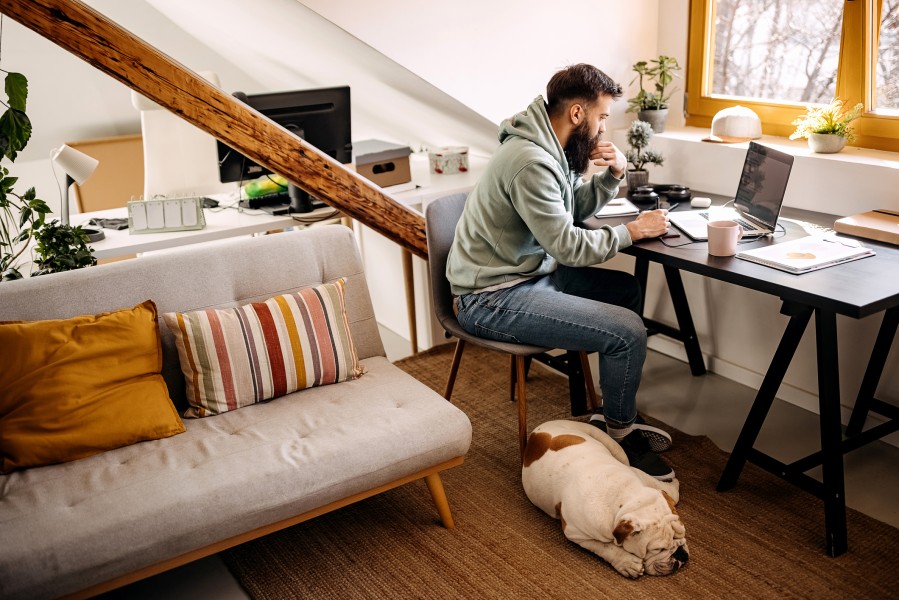
What is your work persona?
Maybe it involves a heavy dose of “Sounds great!” emails or carefully curated meeting small talk or no-nonsense, down-to-business Slacks. But whatever it is, chances are it’s not authentically you. Just as some restaurants conceal their kitchen and hide the “undesirable” back-of-house process from front-of-house patrons, we often get caught in the trap of presenting sanitized, “professional” versions of ourselves at work. But these avatars aren’t us — they’re facades.
Have you ever been to a restaurant with an open kitchen? It’s fun and fascinating to feel engaged in the process of making your food. Sure, you don’t need a close-up view of the fryer, but it’s nice to see what goes into preparing the items you order. It’s certainly more interesting than a beautifully plated meal conjured from the ether by a white-gloved waiter at your beck and call. Similarly, when we bring a perfectly packaged version of ourselves to work, we miss out on the chance to form deeper bonds.
These fake work facades keep us from forming strong connections with the people with whom we spend our weekdays. Coworkers don’t have to be friends, but everyone should be able to show up as themselves. A strong, healthy work culture allows us to display the “back-of-house” traits that make us full people.
I care about creating a work environment where we can be our authentic selves. Not just because I think it makes for a stronger team and better work, but because I think it’s essential to a holistically fulfilling life. In considering how to achieve this goal, here are a few things I’m thinking about.
Why do we want to hide?
I can’t advocate for authenticity at work without acknowledging the decades of expectations that contributed to our neat, sterile work personas. For many years, we’ve been turned into numbers and rewarded for productivity rather than recognized for being true selves. Workplaces are, after all, a business. Bottom lines still matter, but who says an army of corporate robots is the only path to business success?
The large-scale shift to remote work began to shatter some of these neatly placed walls — crying babies, barking dogs and carefully hung wall art suddenly entered the frame of our laptop cameras, adding dimensions to our polished work facades. Seeing coworkers as full people, it’s easier to connect. However, these digital boxes we stepped into also became a new tool for inauthenticity. We can clear real, human messiness out of our Zoom backgrounds and step into “meeting mode” for half-hour chunks with a clean cut-off — side-stepping true work connections all together. Even awkward post-meeting small talk can be wiped away. But again: Is this how we want to spend our days?
In the restaurant example, owners may give several non-aesthetic reasons for a concealed kitchen. They may say that it should be hidden because staff yell at each other, or it’s not presentable. But should they be yelling? Shouldn’t it be presentable? Upon examination, there’s really no excuse. The same applies to our work lives. The reasoning behind our work facades doesn’t hold up to scrutiny. When we hold back from being ourselves at work, we don’t just hurt the business or culture, we prevent ourselves from forming authentic bonds with those around us.
How can we encourage authenticity?
We’ve all gotten those Slacks where someone issues a quick “How are you?” and then you see ten minutes of “This person is typing” before they dive into their real question. That’s not what I mean when I talk about cultivating workplace authenticity. That’s a quick peek behind the facade before slamming the door shut. To me, bringing our full selves to work starts with genuine curiosity.
I hire people not because of what they’ve done, but because of their potential to make our company better, make me better and make themselves better. But to do that, we can’t only talk about work. Fostering these genuine interactions is also just good people skills — showing real interest, caring about others and asking more questions than you answer. We try to emphasize transparency and authenticity at every turn, using Pingboard statuses to denote mental health days or specify what we’re up to, from doctor’s appointments to dog walking. We’ve learned that when people don’t feel shamed for living their lives, they actually enjoy letting their coworkers in.
We all bear a responsibility for normalizing and celebrating workplace authenticity. Personally, I make it a point to check in with team members — casually, over Slack and never off hours — just because. I also make it a point to dress down to communicate that I don’t equate appearance with contributions. As the CEO, my actions might make more of an impact toward this progress, but we can all take these steps. Do you know who your coworkers are after they press “Leave Meeting?” Not everyone wants these close ties at work, but I think we’re all better off from making an effort to connect.
In my experience, this approach completely changes work dynamics. If one of our VPs takes the day off to supervise their kid’s field trip, less senior employees aren’t jealous or bitter — instead they want pictures, because they know and care about others’ lives and feel empowered to do the same themselves.
The reason we form organizations in the first place is because people are stronger together. So why not get to know them?
Can we measure culture?
Is your workplace culture one where employees feel fulfilled, are psychologically protected, have a work-life balance and contribute to the organization? That’s great — but you’re not done.
Culture isn’t just a switch you can flip on and leave alone. It’s like a plant you have to tend to every day. Some issues can be solved with the right policies and people, but without the right belief structure and energy propelling you each day, attempts to grow a stronger culture will fall flat.
That’s why I don’t believe in “Chief Culture Officers.” Culture isn’t a top-down initiative curated by a boxed set of employee happiness features — it’s an innate feeling that everyone is responsible for creating. Employee satisfaction surveys and other metrics have their place, but at the end of the day, culture, to paraphrase John Mayer, like love, is a verb.
Culture, just as authenticity, isn’t a neatly measurable KPI. Just like your value proposition, it starts and ends with your people. We may not be able to measure it, but we can fight the daily fight to make sure people feel a sense of belonging and fulfillment. We’ll never get it entirely right, but that’s also what’s encouraging — we always have tomorrow to do better.
Changing the Workplace Standard
While so many depersonalized, profit-centric behaviors have become etched into the exhausting “professionalism” standard, I think we have a real chance to change these norms. Working from homemade cracks in our curated work facades. If we keep chipping away, I think we’ll find something much more interesting and fulfilling underneath.
We spend a third of our lives at work. Shouldn’t we make this time something we enjoy and cherish, rather than suffer through? If we embrace authenticity and show curiosity every day, I think we can move that needle.
It’s time to stop settling for amazing meals just appearing on the table, and start celebrating what makes them great. How are you cultivating authenticity? To some degree, we’re all ready to drop the facade — so let’s do it together.
